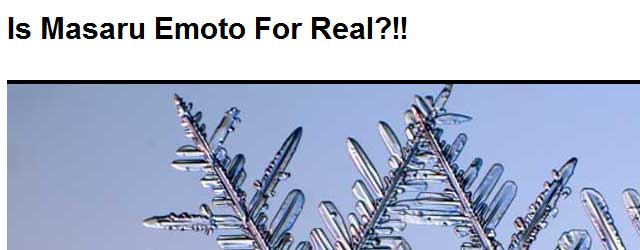Kristopher Setchfield hoorde voor het eerst over de experimenten die Masaru Emoto met waterkristallen deed toen hij het boek van Emoto las The Hidden Messages in Water. Hij was totaal verbijsterd. Door de film What The Bleep Do We Know* werd hij echt geïntrigeerd. Hij begon een onderzoeksproject om te zien of hij voldoende bewijs kon vinden om Emoto’s claims te staven en te reproduceren. *Waarover aanstaande zaterdag een artikel verschijnt.
The idea was to uncover as much information about his methods and procedures as possible to determine if it would actually be feasible to study the effect of energy healing, such as Reiki, on the formation of water crystals. I was so excited to think that I might be the first person in the world to verify his work!
Vervolgens zette hij al zijn bevindingen online op de website: is-masaru-emoto-for-real.com.
Setchfield heeft zijn verhaal van begin tot het eind opgeschreven. Wie is Emoto, welke diploma’s heeft hij, op welke manier heeft hij zijn experimenten gedaan en hoe werkt zo’n ijskristal precies? Ook de wetenschappelijkheid van de door Emoto gedane experimenten worden besproken:
As quoted in an interview with Jon Woodhouse published in the Maui News, Emoto stated, “I did not start out with any modern scientific background. I did not even know the limit of science to stop me from giving this research a chance.” Not having been educated in the scientific community, Emoto has been happy to do his “research” without accurately employing the scientific method. While he does employ the spirit of the scientific method in his research design, he makes critical mistakes in its rigor. For example, Emoto’s research does employ observation of a physical phenomenon, formulation of a hypothesis to explain the phenomenon, and testing and revising the hypothesis, but he makes the critical mistake of failing to minimize the influence of the experimenter’s bias on the outcome of the research.
Dr. Emoto’s procedure for photographing crystals has no controlled means of ensuring that experimenter’s bias is prevented or minimized. For example, his methodology does not ensure that the obtained results are not selected consciously or subconsciously by the photographer. In fact, in the Maui News interview, Dr. Emoto specifically stated, “I do not require any blind tests on any samples,” but rather he believes that “the researcher’s aesthetic sense and character is the most important aspect when taking crystal photographs.” Emoto’s belief that ice crystal formation is sensitive to human thought lead him to select technicians who would not affect crystal formation with negative thoughts over technicians who had formal research experience. [Italics door Maarten]
Dat geeft hopelijk toch wel te denken. Lees het hele verhaal hier.
Lees je liever in het Nederlands, dan heeft Rob Nanninga een vergelijkbaar artikel geschreven.
Het is moeilijk te beoordelen of Emoto een gewiekste zakenman, een oliedomme pseudowetenschapper, een gevaarlijke kwakzalver, een religieuze sekteleider of een aimabele watermysticus is. Misschien alles tegelijk. In een recent interview met Good Times lijkt hij wat bescheidener te zijn geworden: ‘My theory and research is not yet reached science and I should say it is more like fantasy.’
